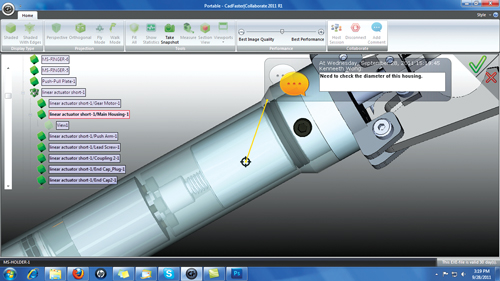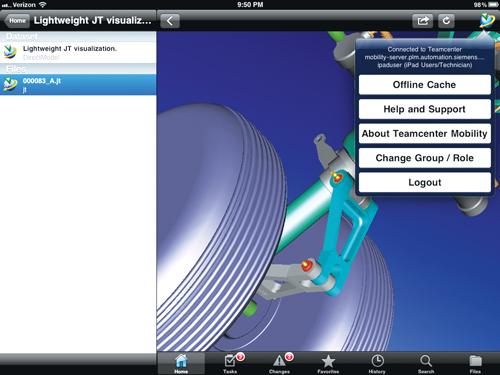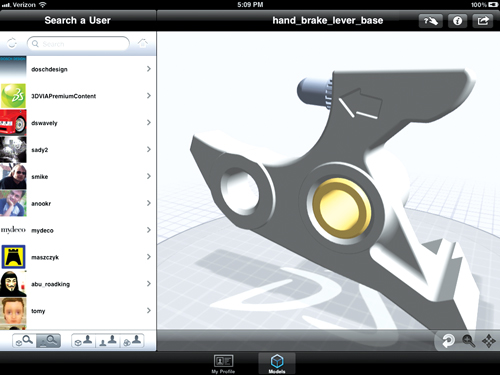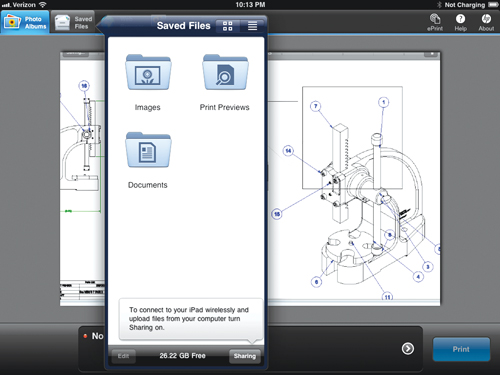Make Me a System with Everything
Boundaries blur as the desktop, mobile apps and the cloud merge.
Latest News
January 1, 2012
By Kenneth Wong
Have you heard the one about a Buddhist monk ordering pizza? The monk walks into a pizza parlor and says, “Make me one with everything.”
It’s OK if you didn’t get it. Apparently, the Dalai Lama didn’t either. When Australian morning show host Karl Stefanovic tried the one-liner during his recent interview with the Tibetan spiritual leader, the joke fell flat. The punch line could mean “make me a pizza with every available topping” or “let me be part of the larger universe,” but somehow the double entendre got lost in translation.

CadFaster bridges the desktop and mobile devices with a CAD plug-in for
exporting mobile-viewable 3D files, an executable file with embedded viewing
and markup tools (shown here), and an iPad app called CadFaster Collaborate.
So why am I repeating the joke (at my own peril) to a bunch of engineers who may or may not be Buddhist? Because the product-design discipline, once confined almost entirely to desktop operations, is heading for a transformation. The new workflow is not confined to local workstations and on-premise client-server setups. It’s also augmented with mobile tablets, smartphones, cloud-hosted functions and online communities. To facilitate smooth data exchange and collaboration these days, you’ll need a product design system where everything becomes one.
Reconciling Your Differences in the Cloud
Some people who regularly shop at Amazon.com may not even realize they have a virtual storage locker, a 5GB Amazon Cloud Drive, waiting for them—free of charge. In March, the online retailer unleashed its Cloud Drive offer, along with free music players for web-connected PCs and Android devices. It’s no coincidence that the size of Amazon’s giveaway was identical to Apple’s iCloud offer, which at the time was still several months away from going public. The Amazon offer, some industry watchers noted, was the retailer’s plan to beat Apple to the punch.
So why are Amazon and Apple so eager to give away free storage? Because the cloud is essential to the appeal of mobile devices like Amazon Kindle and Apple iPad. Both companies foresee that, in the near future, many consumers would use a cloud drive—a small chunk of a remote server dedicated to their multimedia content—as the hub for their ebooks, songs, movies and photos.

Siemens PLM Software’s Teamcenter Mobility 2.0 gives you the option to
work offline (in cache mode), then go back online to sync with files kept in
Teamcenter repositories.
The cloud’s connectivity to your desktop, notebook, Wi-Fi-enabled tablets and smartphones is what allows Amazon and Apple to keep your libraries in sync. It doesn’t matter that you initially highlighted a passage in an ebook or on your PC. You’ll be able to see the same highlight when you access the title from your Kindle device or your iPad. (Amazon calls it Whispersync, emphasizing its ability to quietly reconcile different copies of your content in the background.) Similarly, when you add an appointment to your calendar on your iPhone, you’ll find your desktop’s calendar automatically populated with the same appointment.
Without their link to the cloud, your mobile devices are little more than handheld hard drives. Without automatic synching through the cloud, you will have to painstakingly duplicate every edit you make to your playlists, contacts and photo albums, one device at a time.
This September, Autodesk made a similar move, giving away 3GB of online storage space free of charge to its subscription customers. You may use the online vault to store your design files. But more importantly, many of Autodesk’s mobile applications like AutoCAD WS Mobile and Autodesk Inventor Publisher Mobile Viewer give you direct access to files stored in Autodesk Cloud.
Autodesk’s rival Dassault Syst mes, which offers 3DVIA Mobile app for iPhone and iPad users, gives you a 1GB quota for free. If you need more, you can upgrade to a 3DVIA Online Hosting account—a plan with 5GB to 100GB storage space for varying fees.
As more people begin using mobile devices for concept review, annotation and approval of design changes, the client-server approach (a central repository housed on the premises, accessible only through sanctioned desktop clients) shows its limitations. For product design to scale across multiple devices, the ability to host, share and synchronize mobile-viewable 3D models (usually lightweight versions of CAD models) over the cloud becomes much more important.
Collaboration across Multiple Devices
With an eye toward collaboration across multiple devices, newcomer CadFaster launched its business with plug-ins to some popular CAD software titles (currently available for Bentley MicroStation, Autodesk Revit and SolidWorks) and an iPad app. The plug-in allows you to publish mobile-viewable versions of your 3D design files and directly upload them to your cloud-hosted drive (100MB for a start, with the option to upgrade for more space). It also gives you the option to publish an executable file, which functions as a self-contained viewing and markup application for those who need to inspect the design, but don’t necessarily need to edit the original CAD file.

The 3DVIA Mobile app gives you the option to browse and interact with
3DVIA community content, both members’ and user-submitted 3D models.
Publishing options aside, what distinguishes CadFaster is the co-viewing function, which lets you discuss the shared design file (either as a host or a participant) with a number of others in real-time at the same time. The use of the cloud also allows CadFaster to keep markups and annotations in sync, so notes added to the published model from the iPad app will be visible to anyone launching the file from the desktop, and vice versa. (Because the .exe file with unknown origin can be mistaken for a malicious file by some overprotective antivirus software, at press time CadFaster is considering a thin client as an alternative.)
Previously limited to viewing functions only, Siemens PLM Software’s Teamcenter Mobility now offers users a way to submit tasks into the workflow from an iPad. The app, now in version 2.0, supports Facebook-style notifications (showing the number of issues awaiting your attention on the launch icon itself) and limited markup. The app serves as a portal into Teamcenter databases, housed and maintained by Siemens PLM Software users. The software offers both an offline mode (working from cached data in the device when the device is disconnected) and online mode. Changes made during offline mode will automatically be synced to relevant files when it goes back online.
Community Portals
Long before the emergence of mobile devices, CAD vendors established user communities to foster friendship, file sharing, tip sharing and collaboration among their customers. Long established communities include SolidWorks’ 3D ContentCentral, Dassault Syst mes’ 3DVIA.com, and AutoCAD Exchange. New ones are also springing up, such as GrabCad and Solid Edge PART Community. Some—like SolidWorks’ 3D ContentCentral, 3DVIA.com and GrabCad—support multiple 3D formats and are open to user-created content. Others, like Solid Edge PART Community, are limited to authorized part suppliers with downloadable part catalogs.
SolidWorks’ 3D ContentCentral, which houses both supplier content and user content, is integrated into the CAD modeling software itself, so you can search for a part, download it and insert it into your design in progress, right from the CAD modeling environment. 3DVIA.com content—both user profiles and uploaded 3D files—is available on 3DVIA Mobile, so you can use a Wi-Fi-enabled tablet to browse models, view ratings and histories of users, and inspect the model from your preferred mobile device. Solid Edge PART Community works as an alternative to paper catalogs, offering you a way to download the standard part directly into your Solid Edge modeling environment.

HP ePrint lets you remotely print your drawings to ePrint-enabled printers in
your local area network and web-connected printers. You also have the option
to save and share a digital version of your drawing.
With the introduction of 3DVIA hosting service, you now have the option to embed a cloud-hosted 3D model into a web page (in the same way you might embed a YouTube video clip). After installing the 3DVIA viewer plug-in, visitors to the page can interact with the hosted design model—zoom, pan, rotate, etc.—from a standard browser.
On-demand Horsepower
In some cases, desktop CAD software will be augmented with additional horsepower, available from remote CPU and GPU clusters, delivered on demand over the web. With the latest launch of Autodesk Cloud, the company plans to offer its subscription customers cloud-hosted rendering, design optimization (for Autodesk Inventor users), energy analysis (for Autodesk Revit users), environment footprint calculation (for Autodesk Green Building Studio users), and project management (for Autodesk Buzzsaw users).
Printing over the Web
Even an operation once confined exclusively to paper and stationary hardware—printing—is getting a mobile upgrade. HP, one of a handful of wide-format printer suppliers still in the market, now offers a free mobile app: HP ePrint for iPhone and iPad. With the app installed, you can remotely print your design files to ePrint-enabled printers within your local area network or web-connected printers.
This would allow, for example, a facility manager to print a floor plan directly to an owner’s web-connected printer by emailing the drawing to a unique email address dedicated to the remote printer. That same drawing can also be saved as a digital copy and shared (you’ll need to create an ePrint account), offering you a way to digitally collaborate and physically archive documents at the same time.
Systemic Change
There’s a second part to the joke about the Buddhist monk’s pizza order. After paying for his pizza with a large bill, the monk waited for change, which never came. “Where’s my change?” the monk asked. “Change must come from within,” replied the witty shop owner.
Change is, indeed, coming from within software developers and user communities, inspired by the swift uptake of touch-enabled mobile devices. But a eulogy for the desktop PC is premature. With comparatively smaller hard drives, mobile devices will have to rely on cloud-hosted storage and remote servers, especially to appease those who routinely send, receive and share large 3D design files. The need to reconcile and merge edits and annotations from multiple users using desktop and mobile hardware makes data syncing a critical feature in most apps.
I’ve always believed that the frequent use of the word system (as in “my CAD modeling system”) to refer to a desktop machine is a misnomer. However, in the future, when engineers talk about their system, they may indeed be referring to a collection of hardware and software that act as one—a desktop workstation, a traveling laptop, a mobile tablet, a smartphone and an online vault, always syncing among themselves in the background.
For more on mobile computing’s impact on product lifecycle management, read “Get Ready for RLM: Wherever You May Roam,” DE, October 2011.
Kenneth Wong is senior editor of Desktop Engineering. Contact him via [email protected], at deskeng.com/virtual_desktop or via Twitter @KennethwongSF.
MORE INFO
Subscribe to our FREE magazine, FREE email newsletters or both!
Latest News
About the Author
Kenneth Wong is Digital Engineering’s resident blogger and senior editor. Email him at [email protected] or share your thoughts on this article at digitaleng.news/facebook.
Follow DE





